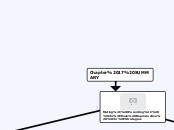によって Graciela Robertson 7年前.
321
Chapter 17 SUMMARY

によって Graciela Robertson 7年前.
321

もっと見る
Sneaking copulations with females instead of fighting for them.
Despite living in multimale-multifemale groups, humans have pattern of low canine dimorphism, low body size dimorphism, and smaller than expected testes for body weight that generally characterizes monogamous primates
Males with more sperm have an advantage in achieving fertilization (obviously) for females who mate with multiple partners
Body size is predictably correlated with testes size, some exceptions (Gorilla = 30g, Chimpanzees = 120g)
Testes size is related to mating systems and competition. Less males (such as one) living together tend to have smaller testes size
Sexual dimorphism in body size can be explained by sexual selection acting as an agent of male-male competition.
Absence of dimorphism doesn't mean that there are aggressive male-male competition exists.
Agressive Competition: 1. Long term: males can compete to monopolize permanent access to females. 2. Short term: males can compete to mate with estrous females. -Varies among species
Investment in young is minimal from males.
Coalitions have positive correlation with aggressive interactions within group
In some species, dentition is monomorphic because females have impressive, male like, canines
- Canine dimorphism correlates with competition levels and sexual selection between male primates - Body size may be more important that male-male competition for attracting females
Infanticide: Generally, a threat within group with large reproductive skew, or from immigrant males from other groups. Therefore, infanticide and infant protection is connected to mate defense.
Having a male protector reduces a lactating female's stress response to the presence of an immigrant male. Ex: Older males/grandpas
How male care --> mating efforts 1. Female choice 2. Promotion of infant survival
Future Reproduction: Male Care allows for increased female reproduction rates which allows for more/future offspring to be born.
Male-Male interactions and use of Infants: males may carry infants during male-male interactions to reduce aggression from other males, or temporarily increase their own status yet, these may vary across species and specifc reasons for infant carrying are unclear.
There is little evidence that males care is beneficial for infants. Yet there are signs that male care may improve infant quality.
Leaders of single male groups show little investment in young. Ex: Silverback mountain gorillas, and Hamadryas Baboons
Costs of Transport: Since traveling, can be costly to the mother, as the infant grows, some species provide paternal care to help the mother. Ex: Callitrichines (twins), -The cost of transport can be solved by "parking" infants as well.
Leaders of single male groups show little investment in young. Ex: Silverback mountain gorillas, and Hamadryas Baboons
Monogamous breeders- paternity certainty is NOT necessary for paternal care. 1. Owl Monkey: monogamous, care is only provided after the infant is born. 2. Titi Monkey: monogamous 3. New World Callitrichines: polyandrous pair units, males will carry, cuddle, play with infants.
Variations of Male-infant interactions 1. Direct care: behaviors that are immediately beneficial for infant welfare. Ex: carrying and provisioning infants, for Cotton-top Tamarins males experience weight loss with few helpers, protection from infanticide. 2. Indirect care: actions that might benefit offspring but would also be performed in the absence of infants. Ex: grooming, playing, and tolerating them.
Prevalence of paternal care 1. Probability of future survival 2. Paternal uncertainty 3. Long-term male-female associations with females increase opportunities for care with infants. 4. Infants are costly, paternal care increase value for survival.